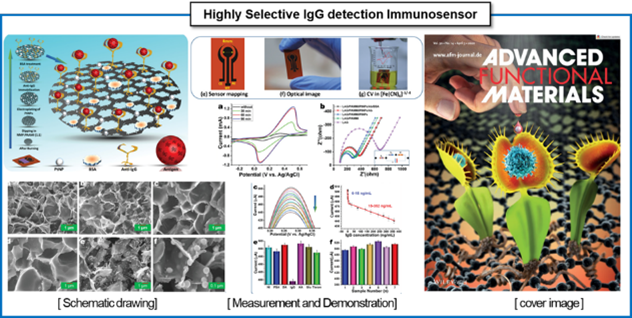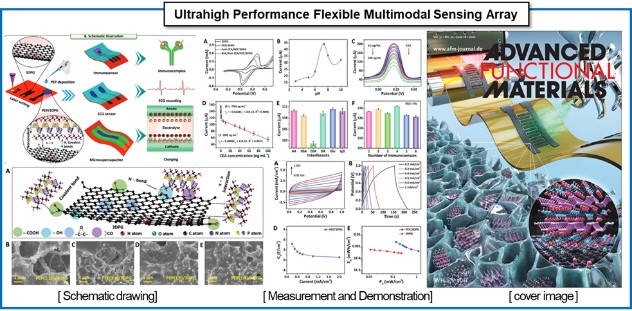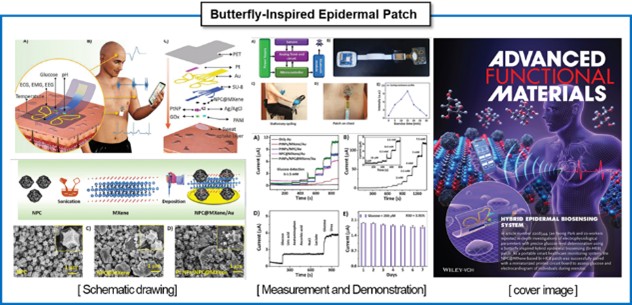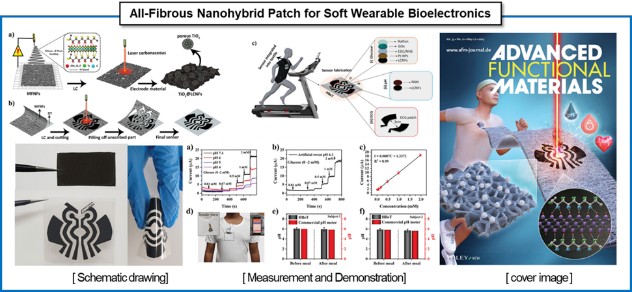Biosensors in Point-of-Care Applications
Disposable electrochemical biosensor: A cost-effective, disposable electrochemical immunosensor platform was developed using polyallylamine (PAAMI)-anchored laser-ablated graphene (LAG). PAAMI functionalizes the LAG surface via noncovalent π–π interactions and electrostatic absorption, offering abundant NH₂ groups for antibody immobilization. This design maintains graphene’s intrinsic conductivity and thermal stability while enhancing biomolecule binding capacity, crucial for minimizing false positives and negatives. Successful PAAMI grafting was confirmed via XPS and Raman spectroscopy. The platform demonstrated excellent performance in detecting immunoglobulin G (IgG) biomarkers, with a wide linear range, and a low detection limit of 6 pg/mL. The high selectivity and sensitivity establish it as a promising candidate for point-of-care diagnostics. Furthermore, this strategy can be extended for detecting other disease-specific biomarkers by simple antibody substitution, offering broad applications in clinical diagnostics, cancer biomarker detection, and real-time monitoring in portable biosensing devices.

Advanced Multifunctional Electrodes
Flexible 3D Porous Graphene Multifunctional Electrode: A flexible, multifunctional 3D porous graphene (3DPG) electrode incorporating polyaziridine-encapsulated phosphorene (PEP) was fabricated using laser writing and drop-casting methods. The integration of highly stable PEP significantly enhanced electrochemical properties, providing abundant active sites and superior surface functionality. The developed PEP/3DPG platform exhibited excellent performance in multiple applications: as an immunosensor, it detected carcinoembryonic antigen (CEA) with wide linear ranges and a detection limit of 0.34 pg/mL; as an electrocardiogram (ECG) sensor, it achieved a signal-to-noise ratio comparable to traditional Ag/AgCl electrodes; and as a microsupercapacitor, it achieved a high areal capacitance, six times higher than non-doped graphene electrodes. These results highlight the versatile utility of the PEP/3DPG architecture for future biomedical diagnostics, wearable health monitoring, and energy storage systems.

Hybrid Physiochemical Epidermal Patch
Epidermal patch for precise sweat and physiological signal sensing : A multifunctional hybrid epidermal biosensing (bi-HEB) patch, inspired by butterfly wing structures, was developed to monitor dynamic fluctuations of sweat biomarkers and physiological signals during on-body tests. The patch integrates a novel nanoporous carbon/MXene (NPC@MXene) transducing layer, supporting a glucose biosensor and pH/temperature sensors. To ensure accurate monitoring, a calibration algorithm corrects for pH and temperature variations in sweat. Additionally, biopotential electrodes record ECG signals with skin-electrode impedance comparable to conventional Ag/AgCl electrodes. The glucose biosensor demonstrated outstanding sensitivity (100.85 μA mM⁻¹ cm⁻²) within the physiological range (0.003–1.5 mM). Combined with a custom-developed wireless monitoring system, the bi-HEB patch enables continuous, real-time tracking of both biochemical and electrophysiological parameters, offering promising applications for wearable healthcare during exercise and rest conditions.

Epidermal Tattoo Sensor
Nanohybrid-Based Soft Bioelectronics Integrated with Textile: While state-of-the-art skin-adhering fibrous electrodes have distinct benefits in personal wearable bioelectronics, considerable challenges persist in the production of fibrous-based soft conductive biosensing nanomaterials and their integration into efficient multisensing platforms. a multimodal electrochemical-electrophysiological patch is developed using MXene/fluoropolymer nanofiber-derived, laser-oxidized TiO₂-interconnected 3D carbon nanohybrid electrodes. The nanohybrid offers high conductivity, rich active sites, and robust enzyme immobilization, enabled by i) conductive MXene cores, ii) fast electron transmission through TiO₂ nanoparticles, and iii) porous carbon bridging effects. Integrated into textiles, the patch simultaneously and accurately monitors sweat glucose (with pH compensation) and electrocardiogram signals, offering scalable design options for real-world wearable applications.

